Courage Of A Tiny Orphaned Rhino
In an Indian park, where every rhino life counts toward keeping the species going, a baby is saved in a monsoon.
By Vicki Croke
Vicki spoke with Here&Now’s Robin Young about the rescued rhino.
The tiny orphaned male rhino, just days old, was discovered holding his own in a rushing stream. He was then handed over to the rescue unit of a rehabilitation center run by the International Fund for Animal Welfare and the Wildlife Trust of India. Photo: Subhamoy Bhattacharjee/IFAW-WTI.
A newborn baby Indian rhino, orphaned just days ago in Kaziranga National Park in Assam, is safe now and being bottle-fed round the clock by teams of experienced caregivers.
In this place, which contains the highest concentration of Indian rhinos in the world, each rhino life counts toward keeping the species going.
The tiny, days-old “neonate” Indian rhinoceros was alone and frightened when he was saved from a rushing stream Monday in the eastern part of Kaziranga National Park in India.
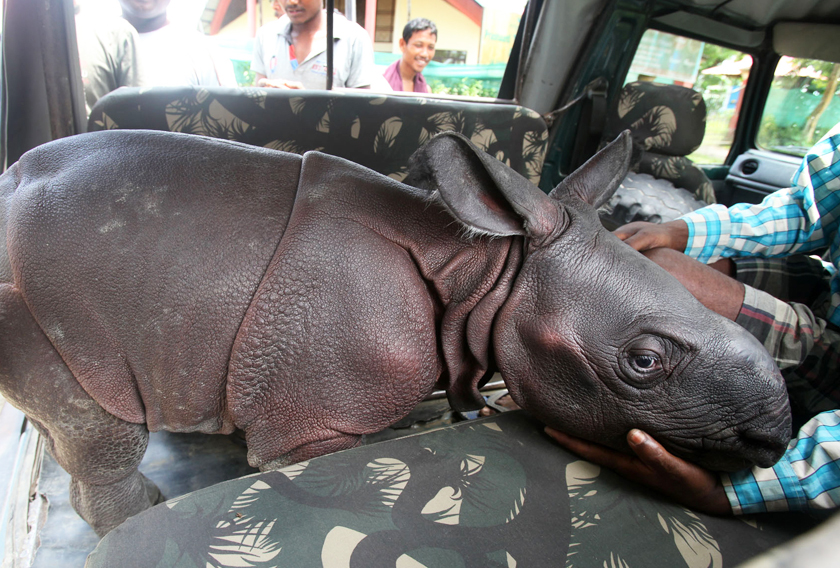
The baby rhino is so young that even his thick, segmented skin looks baggy on him. Photo: Subhamoy Bhattacharjee/IFAW-WTI.
So young that his body-armor skin is still baggy, and his ears too big for his head, he was separated from his mother, and barely holding his own against the current. That’s when one of the park’s anti-poaching teams discovered him. The group was able to pull the calf from the torrent, but once on dry land, his troubles continued. A thorough effort to find his mother turned up nothing.
An animal rescue unit, led by veterinarian Dr. Panjit Basumatary, of the International Fund for Animal Welfare and the Wildlife Trust of India, raced to the site. The calf was found to be suffering from severe dehydration, but showing no external injuries.
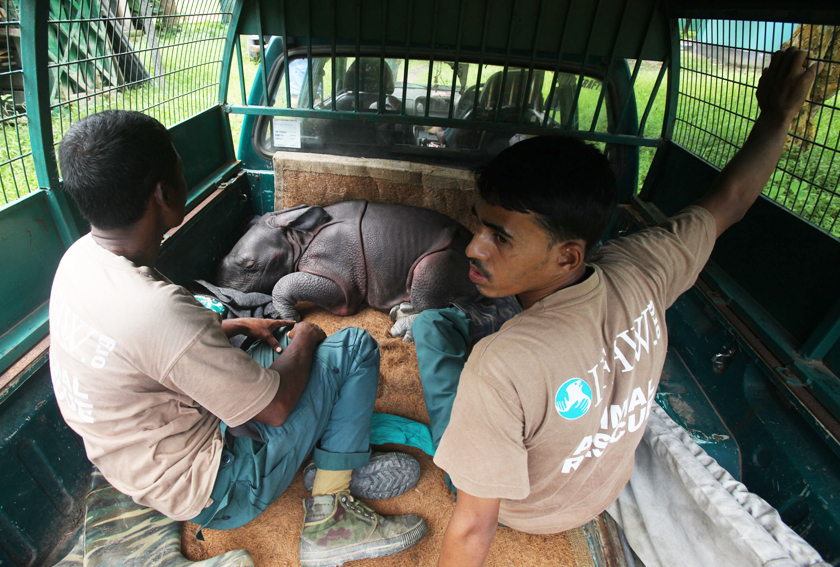
IFAW rescuers rushed the baby, who was severely dehydrated, but otherwise fine, to their rehabilitation center. Photo: Subhamoy Bhattacharjee/IFAW-WTI.
According to IFAW, “After initial assessment by the team, the decision was taken to shift the calf for further care” to the wildlife rehabilitation center run by IFAW in partnership with WTI. The Centre for Wildlife Rehabilitation and Conservation (CWRC), based at the outskirts of Kaziranga, cares for rhinos, as well as elephants, tigers, leopards, buffalo, and deer. In fact, the clinic is sometimes referred to as the Grand Central Station for wild animals in India.
The weigh-in: IFAW-WTI staff at the Centre for Wildlife Rehabilitation and Conservation (CWRC) put the rescued rhino on the scale. Photo: Subhamoy Bhattacharjee/IFAW-WTI.
Aside from the dehydration from not having nursed in a while, the chunky-legged little calf is in good shape. “The calf is doing VERY well,” CWRC’s chief veterinarian Dr. NVK Ashraf, told WBUR’s The Wild Life by phone yesterday. “He has even settled down already.” This is great news for this rhino and for his species in general. Indian rhino numbers, through conservation efforts, have been on the rise.
The world’s population of wild Indian rhinos, often called great one-horned rhinos, is estimated to be more than about 3,000—and the largest concentration of them, about 70 percent, according to the International Union for Conservation of Nature, living inside Kaziranga.
The baby has already settled in and is accepting much-needed formula. Photo: Subhamoy Bhattacharjee/IFAW-WTI.
There are five species of rhino (and 11 subspecies) in the world. Indian rhinos look very different from their African cousins. Second only to Africa’s white rhinos in size, they have single horns, their thick skin-folds resemble body-armor plates, and the skin on their legs and shoulders has a pebbled appearance. They are among the three rhino species found in Asia. Indian rhinos have done well enough to be listed as “Vulnerable” instead of “Endangered” by the IUCN, though they continue to be targeted (as are black rhinos and white rhinos in Africa) for their horns.
There is a hungry and growing market for it in ever-more affluent East Asia where rhino horn is used in traditional Chinese medicine. Far from having magical medical properties, rhino horn is made from the same kind of material as that in our hair and nails.
The rhino has been orphaned at a very vulnerable age, but caretakers are optimistic about his recovery and health. Photo: Subhamoy Bhattacharjee/IFAW-WTI.
But common sense doesn’t stop the demand or the poachers who fill it. The Straits Times (Singapore), as recently as June 30, reported on the problem of poaching in Kaziranga:
Indian forestry officials yesterday found the carcass of a one-horned rhinoceros, killed and de-horned by poachers in Burapahar, a range of the Kaziranga National Park, some 250km east of Guwahati. Illegal rhino horn trade is one of the major environmental issues in the rhino-protected areas of Assam, with the authorities reporting at least 12 killings of one-horned rhinoceroses so far this year.
The battle to protect these animals can be lethal. Three rhino poachers were killed by guards in a gunfight at the park in April.
Poaching does not appear to have been involved in the disappearance of this calf’s mother. Dr. Ashraf, the chief vet at the rehabilitation center says that mothers and babies sometimes become separated during monsoon as the animals seek higher ground.
In this 2014 video from IFAW, an orphaned 3 month-old rhino calf, critically injured in a tiger attack in Northeast India is rescued and rushed to a rehabilitation center run by International Fund for Animal Welfare and Wildlife Trust of India (IFAW-WTI) at the outskirts of Kaziranga National Park.
Dr. Ashraf is optimistic about this most recent rescued calf. He will receive round-the-clock care at the large animal nursery, which has a very good track record caring for these orphans. The center has treated a total of 33 rhino calves in the past. Most recently, three radio-collared former orphans were transferred to a protected pre-release, acclimatizing area in another national park—Manas National Park. And three other rhinos, who were released at Manas, are now said to be breeding.
The rescued baby taking a walk with his “foster mother” at the nursery yesterday. Photo: Subhamoy Bhattacharjee/IFAW-WTI.
If all goes well, this little calf, who’s scheduled to be named sometime next week, will eventually join their ranks. Dr. Ashraf says that for the next few years the rhino will stay at the center. Sometime before the age of three, he will be transferred to a large stockade or “boma” for several months to become acclimated to the forest. After that, Dr. Ashraf says, “we just let them out.”
The calf could grow up to be a massive male—six feet at the shoulder and weighing perhaps five thousand pounds.

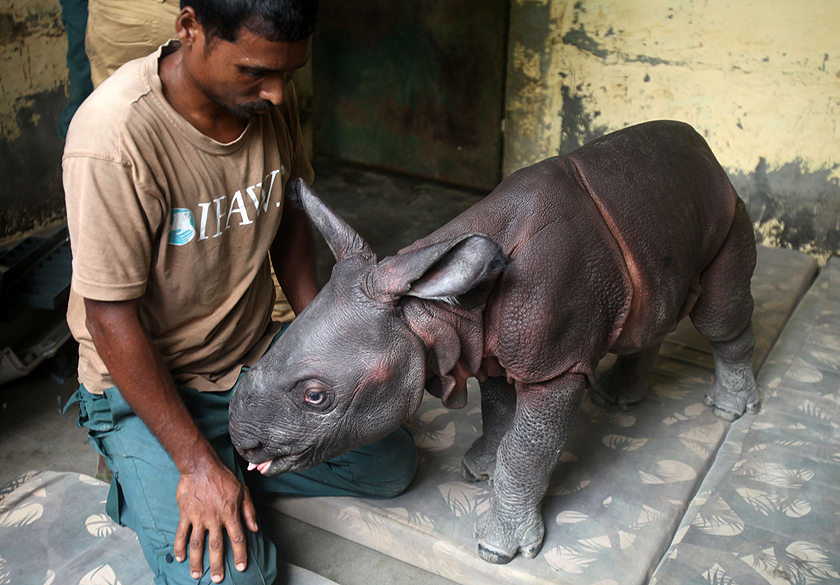
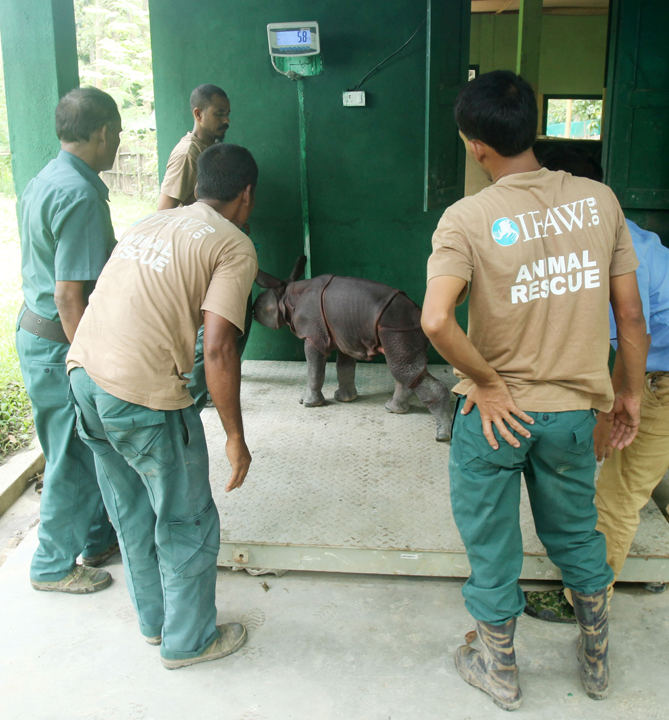
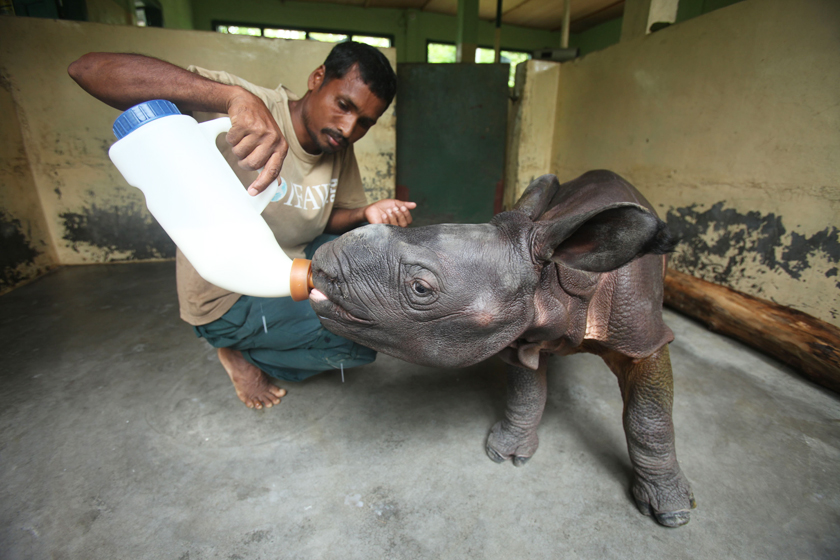
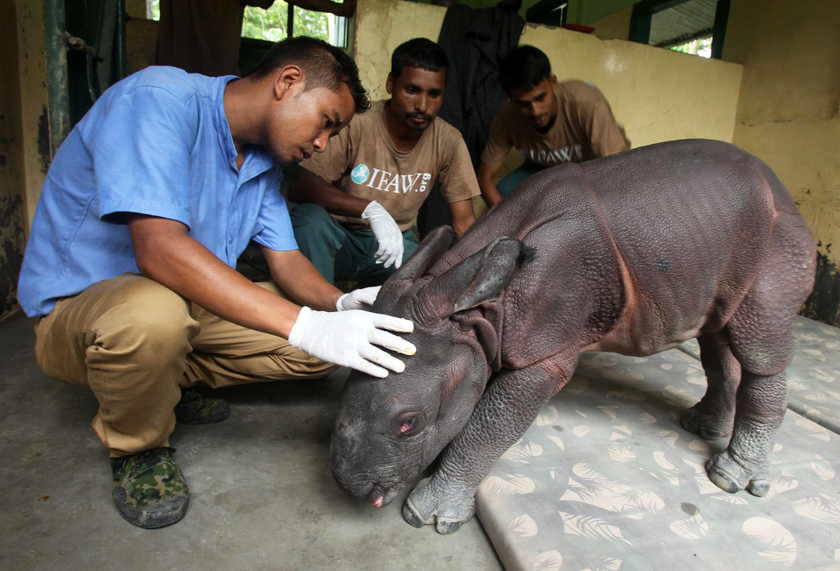

3 Responses to “Courage Of A Tiny Orphaned Rhino”
How cute, i didnt realize there were indiab rhinos
I am raising money for rhinos for my 40th birthday! http://www.crowdrise.com/jeremysrhinowish This organization is one of the several I hope to donate to!
he looks like a dinosaur! :)
animals need help, i cant believe i still read of rhinos and elephants being poached even in the parks made to protect them.
Comments are closed.